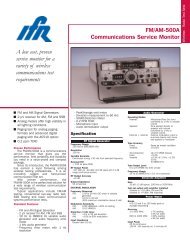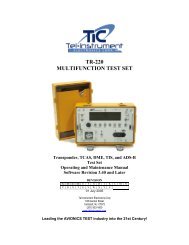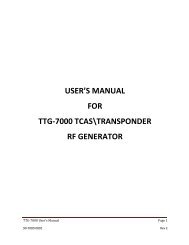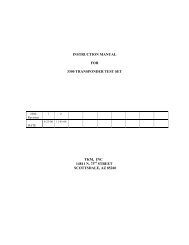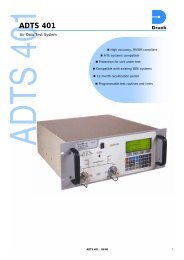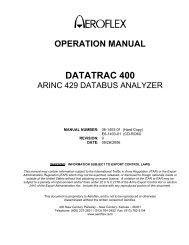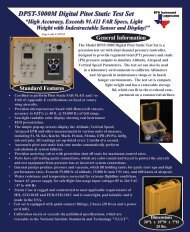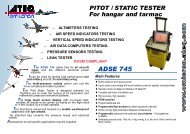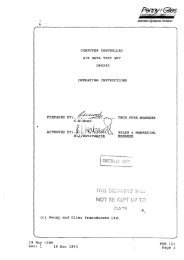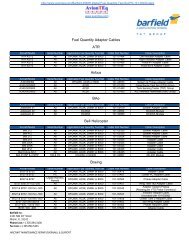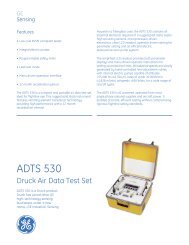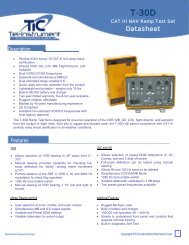PSD30-2AF Fuel Quantity Tester - Aeroflex
PSD30-2AF Fuel Quantity Tester - Aeroflex
PSD30-2AF Fuel Quantity Tester - Aeroflex
You also want an ePaper? Increase the reach of your titles
YUMPU automatically turns print PDFs into web optimized ePapers that Google loves.
OPERATION MANUAL<strong>PSD30</strong>-<strong>2AF</strong>FUEL QUANTITY TESTERMANUAL NUMBER: 06-0816-01 (Hard Copy)E6-0816-01 (CD-ROM)REVISION: 01DATE: 04/26/2007WARNING: INFORMATION SUBJECT TO EXPORT CONTROL LAWSThis manual may contain information subject to the International Traffic in Arms Regulation (ITAR) or the ExportAdministration Regulation (EAR) which may not be exported, released, or disclosed to foreign nationals inside oroutside of the United States without first obtaining an export license. A violation of the ITAR or EAR may besubject to a penalty of imprisonment and/or fines under 22 U.S.C.2778 of the Arms Export Control Act or section2410 of the Export Administration Act. Include this notice with any reproduced portion of this document.This document is proprietary to <strong>Aeroflex</strong>, and is not to be reproduced or otherwisedisseminated without the written consent of <strong>Aeroflex</strong>.400 New Century Parkway – New Century, Kansas – 66031Telephone: (800) 237-2831 / (913) 764-2452 Fax: (913) 782-5104www.aeroflex.com
ELECTROSTATIC DISCHARGE GENERAL WARNINGS FOR ALL EQUIPMENTCAUTION:THIS EQUIPMENT MAY CONTAIN ELECTROSTATIC DISCHARGE (ESD) SENSITIVECOMPONENTS. TO PREVENT ESD SENSITIVE EQUIPMENT FROM POSSIBLEDAMAGE, OBSERVE THE FOLLOWING PRECAUTIONS WHEN HANDLING ANY ESDSENSITIVE COMPONENTS, OR UNITS CONTAINING ESD SENSITIVECOMPONENTS:a. Maintenance or service personnel must be grounded though a conductive wrist strap, or a similargrounding device, using a 1 MΩ series resistor for equipment protection against static discharge,and personal protection against electrical shock.b. All tools must be grounded (including soldering tools) that may come into contact with theequipment. Hand contact will provide sufficient grounding for tools that are not otherwisegrounded, provided the operator is grounded through an acceptable grounding device such as awrist strap.c. Maintenance or service of the unit must be done at a grounded, ESD workstation.d. Before maintenance or service of the equipment, disconnect all power sources, signal sources,and loads connected to the unit.e. If maintenance or service must be performed with power applied, take precautions againstaccidental disconnection of equipment components. Specifically, do not remove integratedcircuits or printed circuit boards from equipment while the equipment has power applied.f. All ESD sensitive components are shipped in protective tubes or electrically conductive foam.The components should be stored using the original container/package when not being used ortested. If the original storage material is not available, use similar or equivalent protectivestorage material.g. When ESD sensitive components are removed from a unit, the components must be placed on aconductive surface, or in an electrically conductive container.h. When in storage or not being repaired, all printed circuits boards must be kept in electricallyconductive bags, or other electrically conductive containers.i. Do not unnecessarily pick up, hold, or directly carry ESD sensitive devices.Failure to comply with these precautions may cause permanent damage to ESD sensitive devices. Thisdamage can cause devices to fail immediately, or at a later time without apparent cause.05-0035-00 Rev 03
<strong>Aeroflex</strong> Operation ManualREVISION HISTORY BY DRAWING NUMBERMANUAL: <strong>PSD30</strong>-<strong>2AF</strong> <strong>Fuel</strong> <strong>Quantity</strong> <strong>Tester</strong>REVISION: 01 – April 26, 2007REV.REV.DRAWING NO. LEVEL DRAWING NO. LEVELDeclaration of ConformitySafety and RegulatoryInformation 01Table of Contents 00Section I 01Section II 00Section III 00Section IV 00DRAWING REVISION HISTORY – <strong>PSD30</strong>-<strong>2AF</strong> – APRIL 26, 2007 – PAGE 1 OF 1
<strong>Aeroflex</strong> Operation ManualSafety and Regulatory InformationReview this product and related documentation to familiarize yourself with safetymarkings and instructions before you operate this equipment.WARNINGThe WARNING notice denotes a hazard. It calls attention to a procedure, practice, or thelike, that, if not correctly performed or adhered to, could result in personal injury. Do notproceed beyond a WARNING notice until the indicated conditions are fully understood andmet.CAUTIONThe CAUTION notice denotes a hazard. It calls attention to an operating procedure,practice, or the like, which, if not correctly performed or adhered to, could result in damage tothe product or loss of important data. Do not proceed beyond a CAUTION notice until theindicated conditions are fully understood and met.Caution (refer to accompanying documents). Attention – refer to the manual. Thissymbol indicates that information about usage of a feature is contained in the manual.The following markings may appear on this equipment:Equipment MarkingsDirect current. This symbol indicates that the equipment requires direct current input.Alternating current. This symbol indicates that the equipment requires alternating currentinput.Both direct and alternating current. This symbol indicates that the equipment requireseither ac or dc input at the same connector.3Three-phase alternating current. This symbol indicates that the equipment requires 3-phase ac input.Earth (ground) terminal. This symbol indicates the ground (earth) terminal.Protective conductor terminal. This symbol indicates the protective ground (earth)terminal.<strong>PSD30</strong>-<strong>2AF</strong> – Rev. 01 – April 26, 2007 – Page i
<strong>Aeroflex</strong> Operation ManualFrame or chassis terminal. This symbol indicates the frame or chassis terminal forconnection to ground.Equipotentiality. This symbol indicates an equipotentiality terminal.On (Supply). This symbol indicates that the power line switch is ON.Off (Supply). This symbol indicates that the power line switch is OFF.Standby. This symbol indicates that the power line switch is in STANDBY.Caution, risk of electric shock. Danger – high voltage.Caution, hot surface. Danger – high temperature surface.Caution (refer to accompanying documents). Attention – refer to the manual. Thissymbol indicates that information about usage of a feature is contained in the manual.In-position of a bistable push control. This symbol indicates the in (on) position of abistable push control.Out-position of a bistable push control. This symbol indicates the out (off) position of abistable push control.CE Mark. of the European Community.Fuse Symbol. To indicate a fuse.<strong>PSD30</strong>-<strong>2AF</strong> – Rev. 01 – April 26, 2007 – Page ii
<strong>Aeroflex</strong> Operation ManualWarningsWARNINGWARNINGDo not use the equipment in a manner not specified in this manual!Equipment should only be serviced by authorized personnel.Proper FuseTo avoid fire hazard, use only a fuse identical in type, voltage rating, and current rating asspecified on the fuse rating label and/or in the manual.Do Not Operate in Explosive AtmospheresTo avoid explosion, do not operate the equipment in an atmosphere of explosive gas.Do Not Attempt to Operate if Protection may be Impaired.If the equipment appears damaged or operates abnormally, protection may be impaired. Donot attempt to operate it. When in doubt, have the equipment serviced.Cleaning WarningKeep the equipment dry to avoid electrical shock to personnel or damage to the equipment.To prevent damage, never apply solvents to the equipment housing. For cleaning, wipe theequipment with a cloth that is lightly dampened with water, mild detergent, or alcohol. Do notuse aromatic hydrocarbons, chlorinated solvents, or methanol-based fluids.Operating PositionNormal operating position is horizontal, on a flat surface. Vertical position is not considerednormal operation.WARNINGEquipment is not intended for wet locations. Miscellaneous liquids on or in the equipmentcould cause hazardous conditions.Safety MaintenanceAny obvious damage to the case (from a drop or fall) should be checked by servicepersonnel for loose or damaged parts inside. See parts lists for approved replacement parts.<strong>PSD30</strong>-<strong>2AF</strong> – Rev. 01 – April 26, 2007 – Page iii
<strong>Aeroflex</strong> Operation ManualTABLE OF CONTENTSSECTION IGENERAL INFORMATIONSECTIONPAGE1.1 EQUIPMENT DESCRIPTION .................................................................................. 1-11.1.1 GENERAL INFORMATION...................................................................................... 1-11.1.1.1 SPECIFICATIONS ................................................................................................... 1-11.1.2 FRONT PANEL COMPONENT IDENTIFICATION .................................................. 1-31.1.3 POWER SUPPLY .................................................................................................... 1-51.1.4 MASTER OSCILLATOR .......................................................................................... 1-51.1.5 6kHz FILTER/AMPLIFIER........................................................................................ 1-51.1.6 CAP REFERENCE DETECTOR.............................................................................. 1-51.1.7 DC CAP DETECTOR............................................................................................... 1-51.1.8 DVM MONITOR ....................................................................................................... 1-51.1.9 BATTERY MONITOR............................................................................................... 1-61.1.10 MEGGER CIRCUIT.................................................................................................. 1-61.1.11 AUTO RANGE.......................................................................................................... 1-61.1.12 A/D SECTION .......................................................................................................... 1-6SECTION IIINSTALLATION AND SHIPMENT2.1 UNPACKING AND INSPECTING EQUIPMENT...................................................... 2-12.2 SHIPMENT............................................................................................................... 2-12.3 INSTALLATION........................................................................................................ 2-12.4 CLEANING............................................................................................................... 2-1SECTION IIIOPERATION INSTRUCTIONS3.1 GENERAL INFORMATION...................................................................................... 3-13.2 CAPACITANCE MEASUREMENT........................................................................... 3-13.3 INSULATION RESISTANCE MEASUREMENT....................................................... 3-13.4 DC VOLTAGE MEASUREMENT ............................................................................. 3-23.5 CAPACITANCE SIMULATION................................................................................. 3-23.6 BATTERY CHARGE READING............................................................................... 3-3SECTION IVSERVICING AND MAINTENANCE4.1 BATTERY REPLACEMENT..................................................................................... 4-14.2 BILLS OF MATERIALS, ASSEMBLY DRAWINGS, AND SCHEMATICS ............... 4-2<strong>PSD30</strong>-<strong>2AF</strong> – Rev. 0 – February 14, 2007 – PAGE 1
<strong>Aeroflex</strong> Operation ManualSECTION IGENERAL INFORMATION1.1 EQUIPMENT DESCRIPTION1.1.1 GENERAL INFORMATIONThe <strong>PSD30</strong>-<strong>2AF</strong> DC Capacitance Field Calibration Unit is a highly accurate test set with the capability tocalibrate and test any DC Capacitance-type quantity measuring systems (“wet” or “dry”). It may be usedfor functional check or calibration of any capacitive liquid quantity gauging system which uses diodeelements integral to the sensor. The <strong>PSD30</strong>-<strong>2AF</strong> provides four basic functions:1. It measures capacitance in picofarads (pF).2. It measures insulation resistance in megohms.3. It simulates one capacitor as required.4. It measures DC voltage.In addition, the <strong>PSD30</strong>-<strong>2AF</strong> provides the capability of displaying the percentage of charge in its powersupply batteriesThe capacitance measuring circuits is auto-ranging up to 1,999pF. Insulation resistance measurement isauto-ranging up to 2,000MΩ. A two terminal switch (“2-WIRE MEGGER”) is provided for isolating systemfaults reading less than the desired resistance (see S5 on Figure 1-1).Operation of the <strong>PSD30</strong>-<strong>2AF</strong> requires selection of the desired function using the “FUNCTION SELECT”switch (S1). For a particular aircraft test, the specific reading on the “POWER/PROBE SELECT” switch(S3) must also be selected. If the “MEGGER” position is selected on the “FUNCTION SELECT” switch,the test points to be read are selected using the “MEGGER SELECT” switch (S2). Aircraft-specificinterface cables are required for each application. These are not supplied with the <strong>PSD30</strong>-<strong>2AF</strong>.The <strong>PSD30</strong>-<strong>2AF</strong> is powered by 18 alkaline “C-cell” batteries which can be replaced without requiringrecalibration of the tester. The battery condition can be determined by selecting the “BATTERY CHECK”position on the “FUNCTION SELECT” switch (refer to Figure 1). If a low battery condition exists, the LCDdisplay will show a “LO BATT” annunciator. Rechargeable batteries may not be used in the <strong>PSD30</strong>-<strong>2AF</strong>.1.1.1.1 SPECIFICATIONSLengthHeightWidthWeightPower RequirementsOther batteriesFuse Requirements10.5 inches6 inches12 inches11 pounds18 C-cell alkaline batteriesNone¼ A Type AGC<strong>Aeroflex</strong> p/n 36-0004-04Located on Switch BoardAccess for qualified servicepersonnell only<strong>PSD30</strong>-<strong>2AF</strong> – Rev. 1 – April 26, 2007 – Page 1-1
<strong>Aeroflex</strong> Operation ManualAltitudeRelative Humidity (Non-Condensing)2000 mMaximum relative humidity 80% fortemperatures up to 31 °C decreasinglinearly to 50% relative humidity at 40°C.Pollution Degree 2Operating TemperatureStorage TemperatureDC Capacitance Reading RangeDC Capacitance AccuracyInsulation Resistance ReadingInsulation Resistance AccuracyDC Voltage Reading(See note below)DC Voltage Accuracy(See note below)DisplayHousing MaterialTest Input Connector-20° C to +50° C-30° C to +60° C0.1pF to 199.9pF in 0.01pF increments200pF to 1999pF in 0.1pF increments± 10% of reading from 0° C to +50° C± 15% of reading from -20° C +0° C100kΩ to 2,000MΩ± 10% of reading from 0° C to +50° C± 15% of reading from -20° C to +0° C0 to +40VDC in 0.01 VDC increments0.5% of full scaleLiquid CrystalABS PlasticMS24264R14B15SNNOTE: The AC voltage inputs on this instrument are Installation Category I inputs. Do not exceed 40VAC. Installation Category I inputs are signal-level inputs with smaller transient overvoltage thanInstallatioon Category II.<strong>PSD30</strong>-<strong>2AF</strong> – Rev. 1 – April 26, 2007 – Page 1-2
<strong>Aeroflex</strong> Operation Manual1.1.2 FRONT PANEL COMPONENT IDENTIFICATION AND DESCRIPTIONRefer to Figure 1-1.Figure 1-1. Front Panel<strong>PSD30</strong>-<strong>2AF</strong> – Rev. 1 – April 26, 2007 – Page 1-3
<strong>Aeroflex</strong> Operation Manual1.1.3 POWER SUPPLYPower enters the unit via the switch board. It is filtered, fused and sent to the main board where it isconverted to all voltage levels required to power the unit. The four LCD back lighting LED’s (DS101-DS104) and U115 along with the function annunciator LED’s (CR110-CR113) a set up as a droppingresistor to the input of the +5V regulator (U116), and for U120, the precision +5V unit reference. U117is the +15V regulator receiving its power from the +27 battery supply. Q102 and T102 is a forwardconverter type supply that inverts the +27V battery supply to –27V all flyback power left in the core ofT102 is routed back to the batteries through CR115. The –27V supplies power to U118, the -15Vregulator. The –15V regulator also supplies power to U119, the –5V regulator.1.1.4 MASTER OSCILLATORU101 and Y101 make up the master oscillator section of the unit. All unit clocks are generated here andare used as follows:1. U101-4 96kHz A/D converter chip clock2. U101-4,6 96kHz & 48kHz Two clocks “anded” to make a 48kHz 25% duty cycle clock for–15VDC generation.3. U101-15 6000Hz Main capacitance excitation signal (LO-Z).4. U101-3 375Hz Auto-range clock1.1.5 6kHz FILTER/AMPLIFIERU102A is the basis for a 6kHz active bandpass filter to convert the 6000Hz clock to a sine wave. Thissignal is routed to U102B to further filter the signal, amplify it and control the final output amplitude of theLO-Z line. U103 is power amp with a gain of 1 to drive T101. T101 provides isolation and level shifting tobring the LO-Z signal to its 20VAC level.1.1.6 CAP REFERENCE DETECTORU104 and associated circuitry detects the frequency and amplitude of the LO-Z line to create the voltagereference to the A/D converter. The components connected to U104 pin 3 are for temperaturecompensation of the capacitance section of the unit.1.1.7 DC CAP DECECTORThe LO-Z line is routed to the aircraft fuel probe. The returning signal is a DC current proportional to thecapacitance of the probe. This return current is nulled by U113 such that the return line from the aircraftappears to be ground. The output of U113 is a voltage representing the DC current returned from theprobe and routed to the A/D circuitry. U114 is an analog multiplexer used to select the grain of U113(depending on the type of probe selected by the user). U137 is another analog multiplexer used forcalibrating the offset of the different probe types.1.1.8 DVM MONITORThe DVM input is scaled by R305, R306, and R307 on the Switch Board (A3) and routed to the A/Dsection of the Main Board (A1). The DVM input divides the input signal by 200 and has an inputimpedance of 1MΩ.<strong>PSD30</strong>-<strong>2AF</strong> – Rev. 1 – April 26, 2007 – Page 1-5
<strong>Aeroflex</strong> Operation Manual1.1.9 BATTERY MONITORThe Battery Monitor Section monitors the charge remaining in the battery pack. It is an expanded scalevoltmeter. The battery voltage is scaled by U108 and expanded such that the output of U108 is 5V,displaying 100% on the unit, when the batteries are approximately 27-1VDC. U108 output falls linearly asthe battery voltage decays and its output is 0V when the batteries are about 18 VDC. U109 upon sensing0V from U118, toggles its output to annunciate LO BAT on the display. U107 ensures the unit stays inthe LO BAT disabled mode as the batteries keep discharging.1.1.10 MEGGER CIRCUITThe Megger Circuit operates as follows: A voltage reference is applied to the unknown resistance to bemeasured, and the return current is detected, scaled, taken to the reciprocal of and sent to the A/Dsection of the unit. U108 creates the reference of –10V using the +5V reference, inverting and doublingits magnitude and applying it to the unknown resistance. U110 nulls the return current and inverts thepolarity resulting in a voltage proportional to the resistance being measured. U110’s mathematicalexpression is 500000*K/R=Vout, where R is the unknown resistance and K is the constant 1, 10, or 100which reflects the gain of the circuit selected by the auto range circuitry. U112 is a multiplexer to selectthe correct feedback to U110 to keep its output at a value usable by the A/D circuit. The feedback iscontrolled by the auto range circuitry the output of U110 is fed to U111, the math chip, which calculatesthe reciprocal of the applied voltage and routes the output to the A/D section. U111 performs themathematical expression 0.25/Vin=Vout.1.1.11 AUTO RANGEThe auto range circuit is made up of 5 IC’s (U121-U125). When an over- or under-range is received fromthe A/D section it is routed through U121, to check for validity, to U123. U123 is an up-down counterused to set and remember the range. U123’s output is routed to the decoder U124 and sent throughoutthe unit. U125 is a miltiplexer used to limit the available valid ranges determined on the selected function.Once a range has been changed U122 delays any range changes for approximately 2.7 seconds to allowfor all circuits to stabilize.1.1.12 A/D SECTIONAll function signals are routed through either U106 or U114, selected by the function switch on the switchboard, to the scaling I.C> U128. One half of U128 selects the reference to the A/D chip U129. In theMeasure Capacitance mode the CAPREF signal is the reference, from the Cap Reference circuit. Allother functions use the +5V reference divided by 10 or 0.5V. the other half of the U128 selects themagnitude of the input signal, either gain of 1 or divides the input by 10. The only signal that enters theA/D chip at a gain of 1 is the low capacitance range, 0-200pF. U129 is the A/D chip capable of 40,000bits of resolution with an accuracy of +/-1 bit. With a reference of 0.5V the A/D will have a full scale inputof 1.0V displaying 20,000 counts on display. The output of U129 is multiplexed and routed to the decodergates U126, U127, U130, U133, U135, and U136 to control the information to the decoder/driver I.C.U134 to drive the LCD display DS109.<strong>PSD30</strong>-<strong>2AF</strong> – Rev. 1 – April 26, 2007 – Page 1-6
<strong>Aeroflex</strong> Operation ManualSECTION IIUNPACKING, INSTALLATION AND SHIPMENT2.1 UNPACKING AND INSPECTING EQUIPMENTExercise care when unpacking the unit. Make a visual inspection of the unit for evidence of damageincurred during shipment. If a claim for damage is to be made, save the shipping container tosubstantiate the claim. When the equipment has been unpacked, return all the packing material to thecontainer for future use in storing of shipping the equipment. Remove any protective covers from theconnectors before using the equipment. Replace any connector covers on the connectors after using the<strong>PSD30</strong>-<strong>2AF</strong>.2.2 SHIPMENTThe <strong>PSD30</strong>-<strong>2AF</strong> is designed to withstand normal usage and handing during shipping. However it isrecommend that if it is to be shipped, the batteries be removed and new ones installed at the destination.Battery replacement will not require recalibration and the reduced weight enhances the unit’s survivability,as well as reducing shipping cost.2.3 INSTALLATIONThe <strong>PSD30</strong>-<strong>2AF</strong> is powered by alkaline batteries. There is no connector to mains voltages.There are not ventilation requirements.2.4 CLEANINGA. Cleaning ItemsB. CleaningSoft lint-free clothSmall soft-bristled brushMild non-abrasive cleanserIsopropyl alcoholCAUTION:DO NOT USE COMPRESSED AIR (SUCH AS FROM AN AIR COMPRESSOR) TO CLEAN THE UNITWITHOUT AN APPROPRIATE AIR TANK FILTER.CAUTION:AFTER CLEANING ELECTRICAL CONNECTORS, ALLOW SUFFICIENT TIME FOR THECONNECTORS TO DRY BEFORE RECONNECTING.Use a small amount of cleanser and a soft cloth to remove residues such as dirt and dust. Ifother substances need to be removed from the equipment exterior, use an appropriate cleanser.Do not use solvent-based cleansers on any painted surfaces, or on the unit Front Panel.<strong>PSD30</strong>-<strong>2AF</strong> – Rev. 0 – February 14, 2007 – Page 2-1
<strong>Aeroflex</strong> Operation ManualC. Equipment InspectionCheck that the Front Panel and covers are not warped, bent, or otherwise damaged.Verify correct mounting alignment for all covers and hardware.Check to ensure that all cover mounting hardware, such as screws and hinges, are present andsecure.Check strain relief fixtures and verify that they are not damaged or worn.Check for defects or wear in the insulation of wires or wiring harnesses.Check connectors for pushed-back pins or sockets.Check connectors for broken or loose wires.Check that the mounting hardware on all connectors and other assemblies is in place and secure.<strong>PSD30</strong>-<strong>2AF</strong> – Rev. 0 – February 14, 2007 – Page 2-2
<strong>Aeroflex</strong> Operation ManualSECTION IIIOPERATION INSTRUCTIONS3.1 GENERAL INFORMATIONThe <strong>PSD30</strong>-<strong>2AF</strong> is a general purpose test set which can be used to troubleshoot and calibrate anycapacitive liquid gauging system which has diodes integral to the sensor. Aircraft-specific interfacecables are required to test fuel quantity.The <strong>PSD30</strong>-<strong>2AF</strong> is battery-powered and current-limited. It is approved as safe for use in all operatingmodes, with fuel in the tank of with the tank dry. Voltage checks between the tester chassis and groundare not required when using the <strong>PSD30</strong>-<strong>2AF</strong>.The <strong>PSD30</strong>-<strong>2AF</strong> should always be connected to airframe ground during system test to permit insulationresistance checks and to insure accurate measurements. However lack of such ground does notconstitute a safety hazard.3.2 CAPACITANCE MEASUREMENT1. Verify that power is removed from the aircraft system.2. Connect “CHASSIS” jack (J4) to airframe ground (or the mounting flange of a tank unit removed fromthe tank).3. Connect the adapter cable to connector J1, and connect the adapter cable to the aircraft.4. Using the ‘POWER/PROBE SELECT” switch (S3), turn on the unit by selecting the appropriateaircraft type. Allow a 3 minute warm-up.5. Select the “MEASURE EXT” position on the “FUNCTION SELECT” switch (S1).6. The capacitance is displayed in picofarads on the LCD display (D1).NOTEIf the capacitance being measured is in excess of the normal range (0-1,999pF), the LCD will indicate“----“.3.3 INSULATION RESISTANCE MEASUREMENT1. Verify that power is removed from the aircraft system.2. Connect “CHASSIS” jack (J4) to airframe ground (or the mounting flange of a tank unit removed fromthe tank).3. Connect the adapter cable to connector J1, and connect the adapter cable to the aircraft.4. Using the “POWER/PROBE SELECT” switch (S3), turn on the unit by selecting a probe type (anyProbe Type position is acceptable). Allow a 3 minute warm-up.5. Select the “MEGGER” position on the “FUNCTION SELECT” switch (S1).6. Using the “MEGGER SELECT” switch (S2), select the appropriate position.<strong>PSD30</strong>-<strong>2AF</strong> – Rev 0 – February 14, 2007 – Page 3-1
<strong>Aeroflex</strong> Operation Manual7. The insulation resistance is displayed in megohms on the LCD display (D1). The unit will indicateover range (“----“ will be displayed) above 2,000MΩ.8. If more than one position of the “MEGGER SELECT” switch indicates a short circuit (“0001”), depressthe “2-WIRE MEGGER” switch (S1) for a more accurate reading.3.4 DC VOLTAGE MEASUREMENTCAUTIONDO NOT CONNECT TO ANY POWER SOURCES OTHER THAN 0-40 VDC.1. Connect “CHASSIS” jack (J4) to airframe ground (or the mounting flange of a tank unit removed fromthe tank).2. Using the “POWER/PROBE SELECT” switch (S3), turn on the unit by selecting a probe type (anyProbe Type position is acceptable). Allow a 3 minute warm-up.3. Select the “DMM JACK” position on the “FUNCTION SELECT” switch (S1).4. Connect the dc voltage under test to the “DMM+” (J2) and “DMM-“ (J3) jacks.5. The dc voltage is displayed in volts on the LCD display (D1).3.5 CAPACITANCE SIMULATION1. Connect “CHASSIS” jack (J4) to airframe ground (or the mounting flange of a tank unit removed fromthe tank).2. Connect the adapter cable to connector J1, and connect the adapter cable to the aircraft.3. Using the “POWER/PROBE SELECT” switch (S3), turn on the unit by selecting the appropriateaircraft type. Allow a 3 minute warm-up.4. Select the “MEASURE INT” position on the “FUNCTION SELECT” switch (S1).5. Adjust the “COURSE” push-button switches (S6) to approximate the desired capacitance.6. Adjust the “FINE” capacitor vernier (C1) to the exact capacitance required.NOTEThe knob on C1 has a “two-speed” type of adjustment. Rotating the knob while pressing down gives a“coarse” adjustment, and rotating the knob without pressing down gives a “fine” adjustment.7. The capacitance is displayed in picofarads on the LCD display (D1).8. Set the “FUNCTION SELECT” switch (S1) to “SIMULATE/DMM” for the signal conditioner to readcapacitance. The display will show a DC voltage (proportional to the capacitance) from the signalconditioner if it is wired on the adapter.<strong>PSD30</strong>-<strong>2AF</strong> – Rev 0 – February 14, 2007 – Page 3-2
3.6 BATTERY CHARGE READING<strong>Aeroflex</strong> Operation Manual1. Using the “POWER/PROBE SELECT” switch (S3), turn on the unit by selecting the appropriateaircraft type. Allow a 3 minute warm-up.2. Select the “BATTERY CHECK” position on the “FUNCTION SELECT” switch (S1) to determine thebattery charge. The charge of the batteries will be displayed as a percentage of the maximumavailable charge. If the “% CHRG” displayed is 10% or less, replace the batteries. Note that if thebattery charge is low, a LO BATT” indication will appear on the display, and the rest of the display willblank until new batteries are installed.<strong>PSD30</strong>-<strong>2AF</strong> – Rev 0 – February 14, 2007 – Page 3-3
4.1 BATTERY REPLACEMENT<strong>Aeroflex</strong> Operation ManualSECTION IVSERVICING AND MAINTENANCEFOR AUTHORIZED SERVICE PERSONNEL ONLYCAUTION:REMOVE CONNECTIONS TO THE BATTERY PACK BEFORE DISASSEMBLING ANY PORTIONOF THE UNIT.ELECTROSTATIC DISCHARGE (ESD) CAN DAMAGE ELECTRONIC COMPONENTS. SERVICEEQUIPMENT ONLY AT AN ESD WORKSTATION OR AREA.When the "% CHRG" indication on D1 (refer to Figure 1) is at 10% or less, the batteries should to bereplaced. To gain access to the batteries, remove the Front Panel.Remove the 10 Phillips screws around the perimeter of the Front Panel. Carefully lift the Front Panel up.Remove the four Phillips screws holding the cover to the rear of the Front Panel. Remove the FrontPanel Assembly by carefully unplugging the Front Panel from the Battery Pack.Disconnect the Front Panel assembly from the Battery Pack. Remove the upper portion of the bracketsholding the batteries in place, and replace the batteries. Make certain that the polarity of each battery iscorrect (refer to Figure 5-1 below). Reinstall the battery brackets, and the Front Panel.<strong>PSD30</strong>-<strong>2AF</strong> – Rev. 0 – February 14, 2007 – Page 4-1
<strong>Aeroflex</strong> Operation ManualFIGURE 4-1. BATTERY LAYOUT4.2 BILLS OF MATERIALS, ASSEMBLY DRAWINGS, AND SCHEMATICSTo assist in the maintenance of the <strong>Aeroflex</strong> <strong>PSD30</strong>-<strong>2AF</strong> <strong>Fuel</strong> <strong>Quantity</strong> <strong>Tester</strong>, Bills of Materials,Assembly Drawings, and Schematics are available in the <strong>PSD30</strong>-<strong>2AF</strong> Maintenance Manual (P/N 06-0816-00 for hard copy, E6-0816-00 for CD) available separately from <strong>Aeroflex</strong>.<strong>PSD30</strong>-<strong>2AF</strong> – Rev. 0 – February 14, 2007 – Page 4-2



